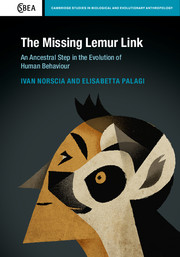Book contents
- Frontmatter
- Dedication
- Contents
- List of contributors
- A message from Jane Goodall
- Foreword
- Preface by the authors
- Acknowledgements
- Part I Communication: from sociality to society
- Part II How conflicts shape societies
- Part III Why lemurs keep in touch
- Part IV Closing remarks
- Looking back to the future – Michael Huffman
- Index
Foreword
Published online by Cambridge University Press: 05 May 2016
- Frontmatter
- Dedication
- Contents
- List of contributors
- A message from Jane Goodall
- Foreword
- Preface by the authors
- Acknowledgements
- Part I Communication: from sociality to society
- Part II How conflicts shape societies
- Part III Why lemurs keep in touch
- Part IV Closing remarks
- Looking back to the future – Michael Huffman
- Index
Summary
We human beings are distinctly unusual in the way we behave, and most particularly in the way in which we process information about the world around us. The final finishing touches to the distinctive manner in which we think and interact seem to have been acquired rather recently. But they were based upon, and made possible by, a complex biological edifice that had been under construction for a very long time indeed. If anything that happened along the winding road of primate and human evolution had failed to happen, for whatever reason, we would not be the creatures we are today. As a result, we are not only who we are, but we are also who we were. Arguably, that long history stretches back to the very beginnings of life on planet Earth; but probably the most useful place to start any rational account of it is with the origin and early evolution of our own unique mammalian order, Primates.
The primate – and ultimately human – edifice has been built, incrementally, over the past sixty million years or so. The foundations and lower floors of that edifice were furnished by the early primates, whose fossils we know from North American, Eurasian and African rocks dating between about sixty and forty million years ago. But these forms are long vanished; and the closest thing we have to living, observable, analogies for those ancient relatives are the strepsirrhine primates of the tropical Old World. Also including a handful of nocturnal species from tropical Africa and Asia, the strepsirrhines are incomparably well represented by the lemurs of the mini-continent of Madagascar. Isolated in their island domain for upward of fifty million years, the lemurs have radiated into an astonishing array of adaptive types: large and small, nocturnal and diurnal, suspensory and cursorial, leaf-eating and fruit-eating, highly arboreal and at least partly terrestrial, eurytopes and stenotopes, gregarious and solitary. Sadly, the larger-bodied representatives of this amazingly diverse and apparently monophyletic primate group are recently extinct, at least partly due to the depredations of humankind. But the surviving species, reckoned to number between fifty and a hundred, depending on the criteria you use to recognise them, still present us with a mind-boggling adaptive diversity.
- Type
- Chapter
- Information
- The Missing Lemur LinkAn Ancestral Step in the Evolution of Human Behaviour, pp. xv - xviiPublisher: Cambridge University PressPrint publication year: 2016

